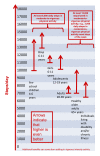How many steps/day are enough? For adults
- PMID: 21798015
- PMCID: PMC3197470
- DOI: 10.1186/1479-5868-8-79
How many steps/day are enough? For adults
Abstract
Physical activity guidelines from around the world are typically expressed in terms of frequency, duration, and intensity parameters. Objective monitoring using pedometers and accelerometers offers a new opportunity to measure and communicate physical activity in terms of steps/day. Various step-based versions or translations of physical activity guidelines are emerging, reflecting public interest in such guidance. However, there appears to be a wide discrepancy in the exact values that are being communicated. It makes sense that step-based recommendations should be harmonious with existing evidence-based public health guidelines that recognize that "some physical activity is better than none" while maintaining a focus on time spent in moderate-to-vigorous physical activity (MVPA). Thus, the purpose of this review was to update our existing knowledge of "How many steps/day are enough?", and to inform step-based recommendations consistent with current physical activity guidelines. Normative data indicate that healthy adults typically take between 4,000 and 18,000 steps/day, and that 10,000 steps/day is reasonable for this population, although there are notable "low active populations." Interventions demonstrate incremental increases on the order of 2,000-2,500 steps/day. The results of seven different controlled studies demonstrate that there is a strong relationship between cadence and intensity. Further, despite some inter-individual variation, 100 steps/minute represents a reasonable floor value indicative of moderate intensity walking. Multiplying this cadence by 30 minutes (i.e., typical of a daily recommendation) produces a minimum of 3,000 steps that is best used as a heuristic (i.e., guiding) value, but these steps must be taken over and above habitual activity levels to be a true expression of free-living steps/day that also includes recommendations for minimal amounts of time in MVPA. Computed steps/day translations of time in MVPA that also include estimates of habitual activity levels equate to 7,100 to 11,000 steps/day. A direct estimate of minimal amounts of MVPA accumulated in the course of objectively monitored free-living behaviour is 7,000-8,000 steps/day. A scale that spans a wide range of incremental increases in steps/day and is congruent with public health recognition that "some physical activity is better than none," yet still incorporates step-based translations of recommended amounts of time in MVPA may be useful in research and practice. The full range of users (researchers to practitioners to the general public) of objective monitoring instruments that provide step-based outputs require good reference data and evidence-based recommendations to be able to design effective health messages congruent with public health physical activity guidelines, guide behaviour change, and ultimately measure, track, and interpret steps/day.
Figures
References
-
- U.S. Department of Health and Human Services. 2008 Physical Activity Guidelines for Americans: Be Active, Healthy, and Happy! Washington, D.C; 2008.
-
- Haskell WL, Lee IM, Pate RR, Powell KE, Blair SN, Franklin BA, Macera CA, Heath GW, Thompson PD, Bauman A. Physical activity and public health: updated recommendation for adults from the American College of Sports Medicine and the American Heart Association. Med Sci Sports Exerc. 2007;39:1423–1434. doi: 10.1249/mss.0b013e3180616b27. - DOI - PubMed
-
- Physical Activity Guidelines Advisory Committee. Physical Activity Guidelines Advisory Committee Report, 2008. Washington, D.C.: U.S. Department of Health and Human Services; 2008.
Publication types
MeSH terms
LinkOut - more resources
Full Text Sources
Other Literature Sources
Medical


